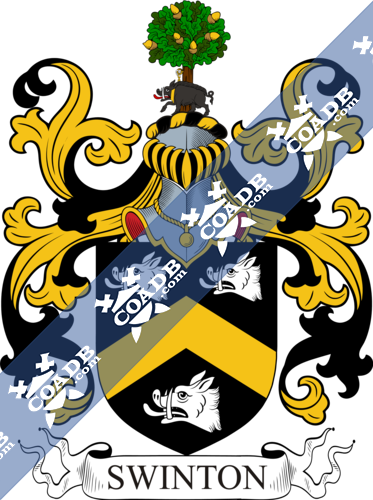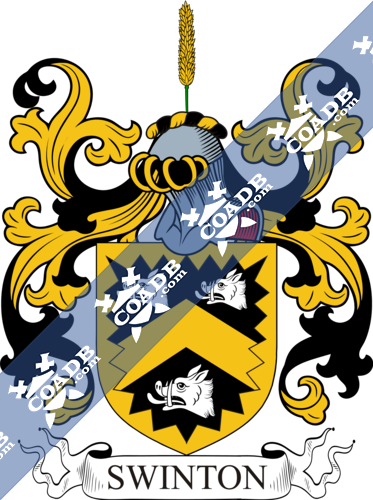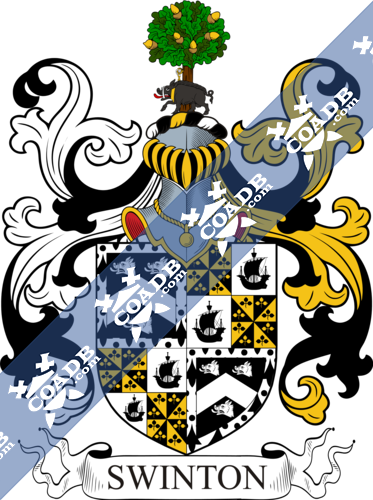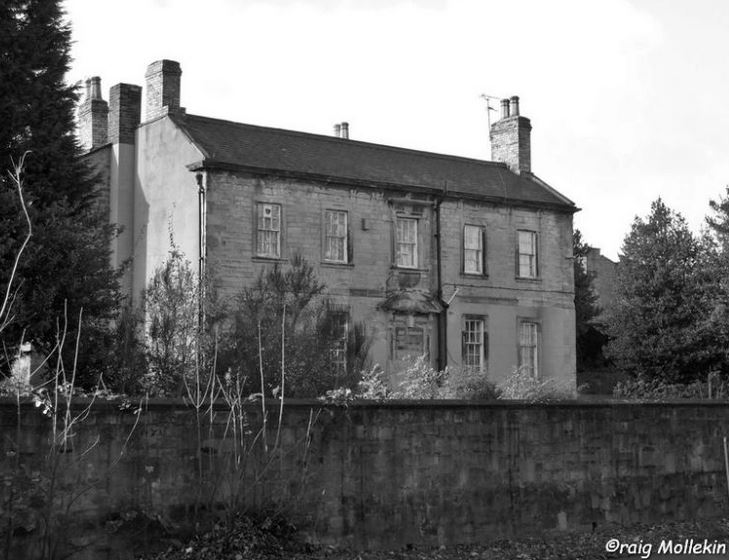Swinton Family Crest, Coat of Arms and Name History

Swinton Coat of Arms Gallery
Don’t know which Coat of Arms is yours?
We can do a genealogical research. Find out the exact history of your family!
Learn MoreSurname Name Meaning, Origin, and Etymology
This English and Scottish surname is a local name meaning “of Swinton”, where were two townships and a chapelry in Yorkshire, England. H.B. Guppy, in his book Homes of Family Names writes: “Swinton is the name of a town both in Lancashire and Yorkshire”. It may have referred to someone who dwelled at the swine enclosure or farm, from the Old English words swin and tun. One source claims the family was first found in Berwickshiore, Scotland where the family held lands for hundreds of years. Another source states the lineage can be traced all the way back to 785 AD.
Spelling Variations
Common spelling variants include Swynton, Swyntone, and Swintone.
Early Bearers of the Surname
One of the earliest bearers was Sir Alan de Swynton in 1240 AD.
History, Genealogy, and Ancestry
The famous genealogist Bernard Burke’s book “Peerage and Knights” discusses two branches of this family in significant detail: Swinton of Swinton Bank and Swinton of Kimmerghame. The first begins with a discussion of John Edulf Blagrave Swinton, Esq. of Swinton Bank in county Peebles, who was born in 1864. His father was John Edulphus Swinton, born in 1832, who married Frances Jane, daughter of Daniel Ainslie, in 1852. Burke states this surname has Saxon roots and took its surname from the barony of Swinton in county Berwick. Edulphus (or Edulf) de Swinton lived during the reigns of King MacBeth (1040-1057) and King Malcolm Cammore (reign 1058-1093 AD), both of Scotland. He had a son named Liulph or Liulf, who in turn had a son named Edard (sheriff in Berwick during the reign of King Alexander I). He was succeeded Hernulf, who obtained charter from King David I. He was succeeded by Sir Alan de Swinton, who received the barony Swinton from Bertram, Prior of Coldingham, during the reign of King William the Lion. Sir John Swinton, a prominent statesmen and solider with high favor from King Robert II and III descended from him. His efforts in the Battle of Otterburn in 1388 are well-known. He married Margaret, widow of William The First Earl of Douglas, but had no children with her. He later married Lady Margaret Stewart, daughter of King Robert II, with whom he had a son named Sir John Swinton. Sir John was known for his valour and he fought at Beauge, France, in 1429 where he killed Duke of Clarence. He later died at the Battle of Verneuil. His second wife was Lady Marjory Stewart, daughter of Robert, Duke of Albany. He was succeeded by his son, Sir John Swinton, who himself died in 1493 AD, leaving a son, with Margaret Falside, named Sir John Swinton. Sir John married Katharine Laude in 1475 and had issue with her, including a son, also named John. This John married Margaret, daughter of David Hume, in 1518 and had eight daughters and two sons with her. He was succeeded by the eldest son, Sir John Swinton. John in turn was succeeded by Robert Swinton, a sheriff in county Berwick. He married Katherine Hay, daughter of Lord Yester, with whom he had a son named John. He later married Jean (of White Castle) in 1597 AD. They had sons named Alexander and Robert, as well as a daughter named Helen. He died in 1628 and was succeeded his son, John Swinton. He died in 1633 and was succeeded by his brother: Sir Alexander Swinton. In 1620, he married Margaret, daughter of James Home, of Framepath, and had five daughters and five sons with her.
The second family was Swinton of Kimmerghame. It begins with a discussion of Archibald Campbell-Swinton of Kimmerghame in county Berwick. He was Professor of Civil Law at the University of Edinburgh from 1842-1862. He was born in 1812 and he married Katharine Margaret, daughter of Sir John Pringle, in 1845. They had a daughter named Katharine Margaret. He secondly married Georgiana Caroline, daughter of Sir George Sitwell, in 1856, and had four issue with her: John Liulf (1858), George Sitwell (1859), Alan Archibald (1863), and Alice Susan Lucy. Burke states this is a branch of the ancient family Swinton of Swinton. Archibald Swinton, Captain H.E.I.C.S, was the 4th son of John Swinton. He served with distinction in India. In 1776, he married Henrietta, daughter of James Douglas, and had issue with her: John, James, Samuel Robert, Harriett, Maria, Agnes, and Elizabeth Catherine. The eldest son was John Sinwton was born in 1777. He was an officer in the army, and he assumed the additional surname Campbell in 1850 when he succeeded his maternal aunt, Mary Campbell, by whom the estate of Kimmerghame, which was sold by his father, was repurchased in 1846. In 1809, he married Catherine Rannie and left issue with her: Archibald (previously discussed), James Rannie (1816), Catherine (876), Mary, Henrietta, and Agnes. The blazon is: Quarterly; 1st and 4th, sable, a chevron or, between three boars’ heads erased arg., within a bordure engrailed ermine for Swinton; 2nd and 3rd, counter quartered, 1st and 4th gyronny of eight or and sable, each charged with a trefoil slipped counterchanged, 2nd and 3rd, arg., a lymphad sa., for Campbell. Crest—a boar chained to an oak tree fructed all ppr Motto—J’espere.
Lieutenant Colonel Alexander Swinton was born in 1732 and died in 1814 in Statesburg, South Carolina. He had married Elizabeth Potts in 1753 and has five issue with her: William, Alexander, Elizabeth, Hannah, and Hugh.
Early American and New World Settlers
Early settlers include John Swinton (New Jersey 1685), Charles Swinton (Maryland 1714), and Peter Swinton (New York 1840).
Mottoes
Swinton family mottoes are 1) J’espere, meaning “I hope” and 2) Dum sedulo prospero, meaning “While engaged industriously I prosper.”
Notables
Famous people with this last name include: 1) John Swinton (1829-1901) who was a Scottish-American journalist who worked for The New York Times, 2) Sir Ernest Dunlop Swinton (1868-1951) who was a British Army officer who helped develop the tank in World War I, and 3) William Elgin Swinton (1900-1994) who was a Scottish paleontologist.
Blazons & Genealogy Notes
1) (Swinton, co. Berwick; now represented by Swinton, of Swinton Bank, co. Peebles; the Berwick estates have passed to a junior branch). Sa. a chev. or, betw. three boars’ heads erased ar. Crest—A boar chained to a tree ppr. Motto—J’espère.
2) (Scotland, 1680). Same Arms, within a borduer indented or. Crest—An ear of wheat growing out of the wreath. Motto—Dum sedulo prospero.
3) (Campbell-Swinton, of Kimmerghane, co. Berwick, 1850). Quarterly, 1st and 4th, sa. a chev. betw. three boars’ heads erased ar. a bordure erm.; 2nd and 3rd, counterquartered, for Campbell, of Blythswood, 1st and 4th, gyronny of eight or and sa. each charged with a trefoil slipped counterchanged, 2nd and 3rd, ar. a lymphad sa. Crest—A boar chained to an oak tree fructed all ppr. Motto—J’espère.


















